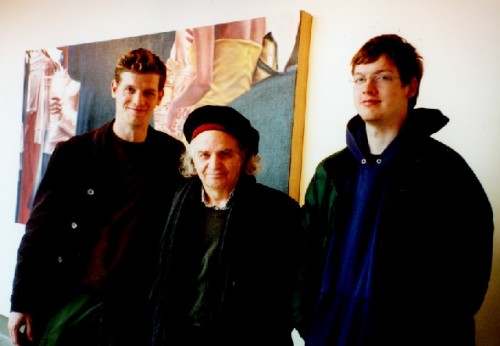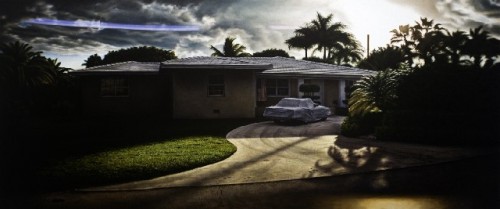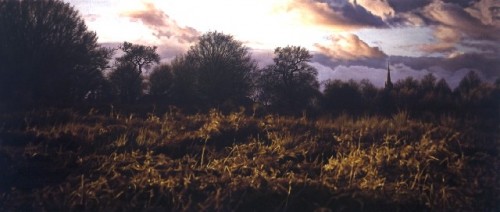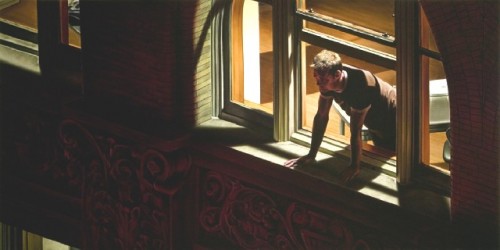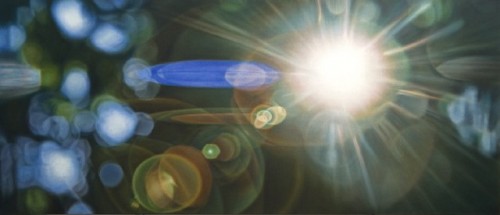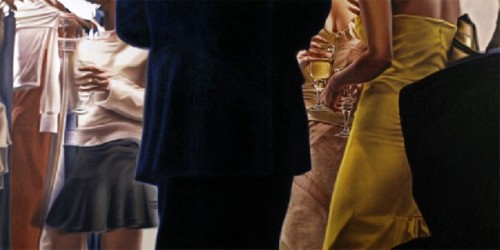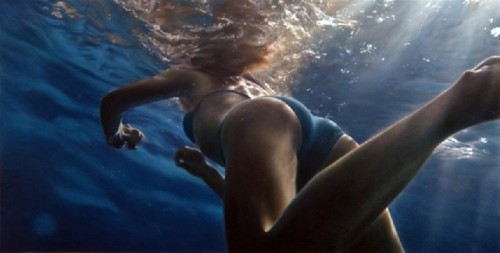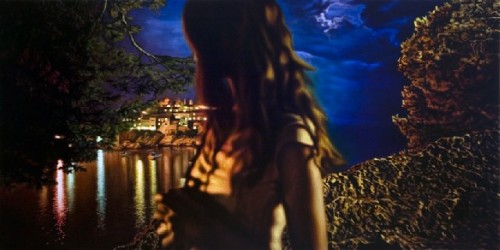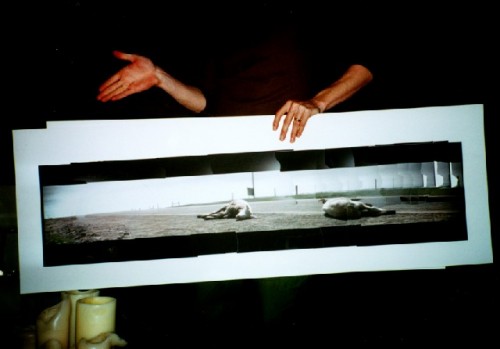Damian Loeb at Acquavella Gallery
Living Well Is the Best Revenge
By: Charles Giuliano - Oct 14, 2008
There were full page ads in the major art magazines promoting "Synethesia, Parataxic Distortion and the Shadow" the September exhibition of paintings by Damian Loeb at the Acquavella Gallery at 18 East 79th Street just steps from the Metropolitan Museum of Art. In keeping with the artists' commitment to film as a resource for the work the ads were designed to resemble the format and credits for movie ads.
The paintings in the exhibition with ten large canvases, all measuring 48 x 96," were scaled to the proportions of a movie screen. The works have titles that are inspired by the classic films "The High and the Mighty" "Vertigo" "Lolita" "Scream" "Straw Dogs" "Darling" "The Seventh Seal" "Rear Window" "The Color of Money" and "M." These, with the exception of "Vertigo" were hung on the main floor of the former townhouse. The Hitchcock inspired painting, a cropped rendering of a nude women swimming, seen from below, was hung next to the staircase and a second floor of galleries. Here were found a series of smaller paintings, 12 x 24" named for the concepts "Pareidolia" "Hypnogogia" "Parataxic Distortion" "Tachypsychia" "The Shadow" "The Mean Reds" "Negative Equality Nostalgia" and "Synesthesia."
As to what the title of the exhibition means, or that series of smaller works, well, I haven't a clue. The essay by Robert Bundy, and the definition of those terms in a brief glossary in the small, handsome catalogue did little to free up the logjam evoked by the obfuscating branding of this first New York exhibition since "Horror Sci Fi" at Mary Boone Gallery in 2003. His other shows with Boone "Public Domain," 2001, and "I Can Stop Anytime," 1999 had more accessible titles.
Clearly, a lot has happened in the five years since Loeb's last New York show. More than just waxing philosophic and post modern by giving his representational paintings, some of the most stunning and compelling of his generation, those obfuscating, big ticket monikers. A great deal of confusion, misinformation and general bad karma continues to haunt the artist even with this movin on up to a blue chip gallery with a limited contemporary stable that includes Lucian Freud and James Rosenquist. This is a sea change from hangin downtown with Boone in Chelsea. The five year interval between New York shows largely reflected a falling out and bitter, contentious, separation from Boone. This was preceded by an even worse debacle with Loeb's first dealer, Jeffrey Deitch. Lawsuits regarding appropriations in the paintings he showed with Deitch left him with debts. When Boone took him on she covered the law suits which kept him indentured to her for the next several years.
Boone appeared to have little interest in developing the status of the artist beyond recovering her investment. As the work of the artist grew and matured she appeared incapable of responding to and supporting his aesthetic process. A show of the new work kept being put off because she was clearly indecisive about how to promote it. Like a lot of dealers she seemed more involved in catching the wave of the next new thing than working with and developing an artist intent on finding new direction.
My first exposure to Loeb's work occurred with the "Public Domain" exhibition in 2001. It came as a shock and surprise. The works of that period were based on collages of movie stills. Although the films were familiar the images depicted were not. It was hardly obvious that a dead carcass on the side of a stretch of highway "Wyoming 44-838 (I Feel Fine)" was extracted and tweaked from an establishing shot in "Close Encounters of the Third Kind." The source was less of interest to me than the compelling image and its enigmatic lure.
As a visitor to New York I was unaware that Loeb, at that time, was often in the limelight of the social pages. He was engaged to Plum Sykes an editor of Vogue. She later wrote a trashy, revenge novel "Bergdorf Blondes" which sold some 250,000 copies. Loeb and several other high profile New York artists were the subject of a scathingly sarcastic article in Newsweek by Peter Plagens that attacked them more for trendy lifestyle than their actual work. In response to Plagens, I wrote an article "The Young and the Restless" that took on the egregious approach of the critic. Link to Young and the Restless
Later, through the Boston art dealer, Mario Diacono, I was introduced to Damian and initiated regular studio visits starting in 2003. It was an interesting time to connect. After breaking off with Sykes he withdrew from the social scene. He told me how much he had hated that lifestyle and wanted little or nothing to do with the art world. By then he was married to the tall, stunning, and brilliant, Oxford educated Zoya Todorovic. They have a daughter Vivian. Damian has another, college aged, daughter, Cameron, from a prior relationship.
For the most part, with the exception of Charlie Finch, Damian had been largely attacked and misunderstood by the New York art critics. Part of this was a hold over of his bad boy image and legacy from the Deitch era of sophomoric, sensational paintings. He was a notorious high school dropout and autodidact. His media running buddy was a childhood friend, the musician Moby. Over time they drifted apart. Today, reflecting his deep interest in film, and ambition to be a filmmaker, Damian hangs with the comedian Mike Myers.
When I began to visit the studio it was a time of transition and change. In defiance of the mantra "if it ain't broke, don't fix it" he was determined to do just that. There were standing orders for the next generation of the enormously successful "Movie Stills." The collages were finished for a new series which was largely reserved by an eager list of clients. There was a stack of canvases ready and waiting. Instead Loeb gave them away to an artist friend. One last movie still, a large square canvas "Can't You Take a Joke," based on "Halloween," was completed because it had been paid for.
Having evolved from the appropriations that had ended in those disastrous copyright suits and the successful "Movie Stills" he wanted to photograph and paint his own images as well as work on scripts for films. Ironically, while in fact appropriations; he never had legal problems with the "Movie Stills." Many were acquired by Hollywood producers and directors.
It would have been simple and obvious to keep with a successful and lucrative formula. Particularly, as a means of getting out from under his financial obligations to Boone. I was present during one of their studio meetings and it was all too obvious that she lacked patience and understanding of his ambitious new work.
During the many meetings with Loeb it was both fascinating and frustrating to discuss the work. While it was fairly straightforward to sketch in his biography and evolution there was a dead end in coming to terms with a critical analysis of content, iconography, and interpretation. The head butting and grappling was always exciting and productive even though there was little prospect of resolution. There was, however, the evolving relationship of watching the growth and progress of a dramatic and bold strategy. Initially, there was little assurance or indication that the back order of collectors would sign on to the new and unexhibited work. Despite the challenges there was a steady flow of sales. Because of Boone's ambivalence, however, the work was not shown or reviewed (in New York) over the past five years of its development. The new work was shown in Europe at Jablonka Gallery in Cologne, the Kunsthalle in Hamburg, White Cube in London, as well as single works, on two occasions, with Diacono in Boston.
Sitting at the computer Damian showed me a selection of the thousands of digital images he had saved to the hard drive. He was constantly sorting through and discarding images. By now he was virtually a hermit in the studio but would accompany Zoya on modeling assignments as well as trips to Europe to visit her family. Many of the images were created during these excursions. But other than this serendipity Loeb never went on location, as such, to scout for themes and subjects.
Often as we were scanning through images I might comment on something as particularly enticing or worthy of a painting. In general, he did not respond or gave enigmatic comments when asked about them. The feeling was that if he could explain the image there would be no need to paint it. Or that explaining would somehow spook it. But it was always exciting when some of those favorite shots did indeed end up on canvas.
As photographs I found the images so compelling that I asked if they might not be seen and exhibited as digital prints. This actually occurred during a small show of paintings and collages at the Aldrich Museum in 2006. There was a wall with a grid of photographs. One may only hope that there are more such occasions. Link to Aldrich review
Probing into Loeb, his development, and intentionality has been a long and winding road. But with an uncanny clarity to its ultimate trajectory. During our first session he produced a book illustrating the techniques of the Old Masters. It had been his source for how to paint. He has always indicated more interest in the technique than style, content, and iconography of art history. Loeb is always more direct on how a panting was made than what it is about. He conveys the lopsided insights and prejudices of the self educated. In the beginning, with the strident, sensational juvenilia of the Deitch appropriations he was just looking for something to copy. He was combining a skill at rendering with attention getting subject matter. It put him on the map, as a talented bad boy and art star, but strapped him with legal hassles and debt.
As he evolved, like many of his generation, his real education came through media, television, and a passion for movies. He created his own theatre in the basement of the loft and I spent an afternoon there as he discussed and dissected "Close Encounters." Later, he showed me the collage which resulted in the painting. The Aldrich show was particularly valuable for illustrating this process.
From the approach and background of an art historian, however, it has often been frustrating to relate to Loeb and his fixations on film. While an involvement with film is a rich resource there are disconnects when the moving image evolves into the single frame of a painting. It must then conform to an entirely different syntax and vocabulary perhaps now exacerbated by the conundrum of text and title for the recent Acquavella show.
As an art historian, for example, one sees the 2005 painting "Rear Window" as more about Edward Hopper than Alfred Hitchcock. There has always been a lot of the haunting Hopper ennui in Loeb's paintings. Never more directly than in this work with a young man leaning out a window. The twist is that although Hopper painted almost identical subjects they were always of women. Here Loeb has converted the gender. Also, it is not even accurate Hitchcock. In the 1954 film Jimmy Stewart, confined to a wheel chair with a broken leg, observed neighbors from the shadows of his apartment using a camera with a telephoto lens.. The character never, as here, leaned out the window. So the title is a stretch.
As is "Straw Dogs" one of the best paintings in the Acquvella show. The brilliantly painted view of a scraggly hay field at twilight, with a church spire on the horizon, evokes late Constable far more than Sam Peckinpah's violent 1971 film. We would hope that Loeb pursued more pure landscape paintings such as this. But he shows little interest in exploring a series of related images as would Constable or Monet.
Consider an image of a woman floating on a raft in a pool. Her bikini clad buttocks are enticingly elevated and erotic. When it was displayed to me on his computer screen Damian explained that it was a young girl photographed with a telephoto lens. Here it is seen as "M" evoking the 1931 Fritz Lang movie with Peter Lorre as a child killer. The title gives a creepy twist to a voyeuristic image. Scopophobia is subtext of the image.
Arguably, the best picture in the Acquavella show is "The Color of Money." It depicts what looks like a single story, California ranch house with a car in the driveway covered by a tarp. There are palm trees above the roof line. While more contemporary there is still that Hopperesque enigmatic mood with the long, brooding shadows of late afternoon. Again the title falls short in evoking the 1986 Martin Scorsese film with Tom Cruise and Paul Newman as hustlers and pool sharks.
Because this one man show was so long coming it is unfortunate that some really terrific paintings got away and have not been included. Over the past five years they were sold and some but not all were borrowed back. This also resulted in including works that, in my opinion, are eccentric to the oeuvre and not successful. The rendering of reflections of "Lolita" and the streaming lights of "The High and the Mighty" have struck me as experiments. They seem to divert and dilute the thrust of the show which evokes establishing shots with premonitions of dramatic tension.
Let us hope that one day there will be a full scale museum exhibition and monograph that pulls together all of this rich, diverse, and often riveting material. By now it is well established that Loeb has unique talent. He may be the best representational painter of his generation. But we anticipate him looking long and hard at where he fits into art history and a bit less time pursuing his muse through the movies. It is also possible that the balance will tip the other way as the paintings become a means of financing ambitions to make movies. Actually, it is exactly what he has wanted from the very beginning. Just ask him. But don't expect to get a straight answer


